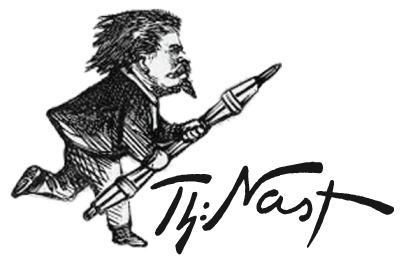
Harper’s Weekly – June 6, 1874
Three weeks after lionizing President Grant for vetoing the Inflation Bill, Nast — in an unusual move — derided its Republican Senatorial sponsors who had been sharply vritical of him for criticizing them. The opposition press described Nast’s cartoon as “Brutal,” “Disgusting” and “Degrading.” One of the signs at the Senators’ feet in this cartoon was from the imaginary Genteel Critic: “Most infamous and brutal caricatures ever published by the Harpers and their Nasty artist.”
Nast often battled with his editor, George William Curtis, over the cartoonist’s portrayals of the editor’s Congressional friends. On this occasion, Curtis responded with a Harper’s editorial criticizing inflation, while explaining that it was a hard topic to caricaturize in the abstract, and strongly supporting his cartoonist.
With that unusual endorsement, Nast doubled down by inserting himself in a tableau on the Senate floor, bowing deeply and sarcastically apologizing to the offended quartet. His Shakespearean titles were casually derived from Julius Caesar (Act V, Scene I) and Winter’s Tale (Act III, Scene 2).
As Nast told his contemporary biographer Albert Bigelow Paine, his Republican targets were angry. Senator John Logan complained to Nast’s friend Norton Chipman: “Little Nast thinks he can teach statesmen how to run the government! Anybody might think he runs it himself!”
Of course, Chipman defended his friend. “Never mind, Logan; it is a distinction to be really caricatured by Nast. Just think what it would be to indicated by a tag.” (Remembering Gratz Brown, Horace Greeley’s Vice Presidential candidate two years earlier, who was portrayed 41 times as a tag on Greeley’s symbolic white coat.)
Rubbing it in, the statement behind the Senators read: “Republican Senators can repudiate their platform, the national debt, or whatever they wish, but nobody may say anything against them because they are sacred.”
